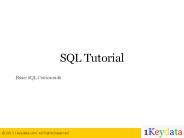PL/SQL - PowerPoint PPT Presentation
1 / 12
Title:
PL/SQL
Description:
PL/SQL Writing Executable Statements PL/SQL Block Syntax and Guidelines Statement can be split across lines, but keywords must not be split Lexical units can be ... – PowerPoint PPT presentation
Number of Views:39
Avg rating:3.0/5.0
Title: PL/SQL
1
PL/SQL
- Writing Executable Statements
2
PL/SQL Block Syntax and Guidelines
- Statement can be split across lines, but keywords
must not be split - Lexical units can be classified as
- Delimiters (simple and compound symbols) These
are characters that have special meaning to
PL/SQL, such as arithmetic operators and
quotation marks - Identifiers, which include reserved words
- Literals (is any value (character, numeric, or
Boolean true/false) that is not an identifier.
123, "Declaration of Independence," and FALSE are
examples of literals ) - Comments
3
Identifiers
- Can contain up to 30 characters
- Must begin with an alphabetic character
- Can contain numerals, dollar signs, underscores,
and number signs - CANNOT contain character such as hyphens,
slashes, and spaces - Should NOT have the same name as a database table
column name - Should NOT be reserved words
4
PL/SQL Block Syntax and Guidelines
- Literals
- Character and date literals must be enclosed in
single quotation marks. - Numbers can be simple values or scientific
notation. - A PL/SQL block is terminated by a slash ( / )
on a line by itself.
v_ename 'Henderson'
5
Commenting Code
- Prefix single-line comments with two dashes (--).
- Place multi-line comments between the symbols /
and /. - Example
... v_sal NUMBER (9,2) BEGIN / Compute the
annual salary based on the monthly
salary input from the user / v_sal
p_monthly_sal 12 END -- This is the end of
the block
6
SQL Functions in PL/SQL
- Available in procedural statements
- Single-row number
- Single-row character
- Data type conversion
- Date
- Timestamp
- GREATEST and LEAST
- Miscellaneous functions
- NOT available in procedural statements
- DECODE
- GROUP functions
7
Datatype Conversion
- Convert data to comparable datatypes.
- Mixed datatypes can result in an error and affect
performance. - Conversion functions
- TO_CHAR
- TO_DATE
- TO_NUMBER
DECLARE v_date VARCHAR2(15) BEGIN SELECT
TO_CHAR(hiredate, 'MON. DD, YYYY')
INTO v_date FROM emp WHERE empno
7839 END
8
Nested Blocks and Variable Scope
- PL/SQL blocks can be nested wherever an
executable statement is allowed - A nested block becomes a statements
- An exception section can contain nested blocks
- The scope of an identifier is that region of a
program unit (block, subprogram, or package) from
which you can reference the identifier
9
Identifier Scope
- An identifier is visible in the regions where you
can reference the identifier without having to
qualify it - A block can look up to the enclosing block
- A block cannot look down to enclosed blocks
10
Qualify an Identifier
- The qualifier can be the label of an enclosing
block - Qualify an identifier by using the block label
prefix
ltltoutergtgt DECLARE birthdate
DATE BEGIN DECLARE birthdate
DATE BEGIN . . . outer.birtdate
TO_DATE(03-AUG-1976, DD-MON-YYYY) END
. . . END
11
Operators in PL/SQL
- Logical
- Arithmatic
- Concatenation
- Parentheses to control order of operations
- Exponential operator ()
12
Determining Variable Scope
- Class Exercise
ltltoutergtgt DECLARE V_SAL NUMBER(7,2) 60000
V_COMM NUMBER(7,2) V_SAL 0.20
V_MESSAGE VARCHAR2(255) ' eligible for
commission' BEGIN DECLARE
V_SAL NUMBER(7,2) 50000 V_COMM
NUMBER(7,2) 0 V_TOTAL_COMP NUMBER(7,2)
V_SAL V_COMM BEGIN ... V_MESSAGE
'CLERK not'V_MESSAGE outer.V_COMM V_SAL
0.30 END V_MESSAGE
'SALESMAN'V_MESSAGE END































